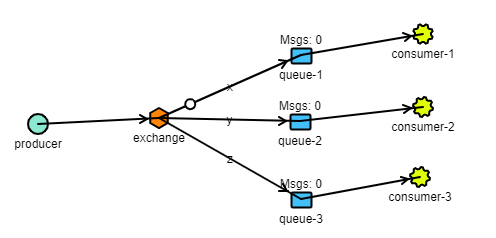What is RabbitMQ?
RabbitMQ is an open-source message-broker software written in Erlang.
It's called Rabbit because it was originally developed by Rabbit Technologies Ltd. 🐇
- It is very reliable and used by a large number of companies
- Fast and powerful with in-memory processing
- It implements multiple communication protocols such as AMQP, MQTT, STOMP e HTTP
- It's a platform-agnostic solution
How does it work?
Essentially, here are some core players in RabbitMQ.
- Producer - application who sends the message
- Consumer - application that receives the message
- Message - information that is sent from a producer to a consumer
- Exchange - message routing agents
- Queue - a sequential data structure that is a medium through which messages are transferred and stored
A binding is like a link you set up to bind a queue to an exchange.
The routing key is a message attribute the exchange looks at when deciding how the message will be routed to queues depending on the exchange type.
Basic flow
A producer sends a message to an exchange. An exchange is responsible for routing the message to different queues with the help of header attributes, bindings, and routing keys. The consumer can be subscribed to a queue and receive the message.
Types of exchange
- Direct - route messages to queues based on a routing key
- Fanout - route messages to all queues that are bound to it
- Topic - route messages to queues that match a wanted pattern
- Header - route messages based on header arguments

Queue
The queue works in FIFO (First In, First Out) pattern.
There are some important queue properties:
- Durable - if the queue must be saved even after the broker restart (disk persistence or just in memory)
- Autodelete - remove the queue automatically when the consumer disconnects
- Expiry - defines the time that there are no messages or clients consuming and when this time is reached, the queue is deleted
- Message TTL - 'message time to live', if the message gets to it and it is not consumer, then it gets excluded
- Overflow - when the queue is so busy that is overflowing
- Drop-head - older messages are removed to receive new ones
- Reject publish - queue rejects messages
Reliability
RabbitMQ has some resources that can be configured to ensure that messages are always delivered, even encountering failures of various kinds.
- Consumer acknowledgment - when the consumer confirms the message receive
- Publish confirm - exchange returns to the producer if it receives the message
- Queues and durable messages
RabbitMQ simulator
There's a great simulator to understand how it works called Try RabbitMQ.
RabbitMQ via Docker
You can also run RabbitMQ on your own and see how these concepts work.
To run it via Docker:
docker run -d --rm --name rabbitmq -p 5672:5672 -p 15672:15672 rabbitmq:3.11-management
RabbitMQ user and password is guest.
You can also check more downloading and installation options.